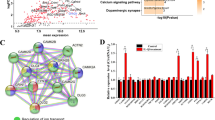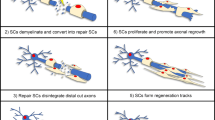Summary
The dynamics of the retrograde transport of [125I] nerve growth factor (NGF) and horseradish peroxidase (HRP) in dorsal root ganglion (DRG) neurons were studied in rats. After injection of [125I]NGF or HRP into crushed sciatic nerve, labelling was examined in spinal nerves, dorsal root ganglia, dorsal roots and spinal cord. Retrograde transport of either [125I]NGF or HRP was first observed in DRG neurons 6 h after injection: The maximal rate of transport (7mm h−1) was similar for both proteins. Significant differences in the sizes of DRG neurons labelled by [125I]NGF were observed and were dependent upon survival time. No such difference was seen in HRP-injected animals. At 6 h after injection, 60% of all the HRP-labelled cells had a diameter of more than 25 μm, whereas 90% of all the [125I]NGF-labelled neurons had a diameter of less than 25 μm. With increasing survival times there was a gradual shift in the size of [125I]NGF-labelled neurons towards larger diameters. Thus, 24h after the [125I]NGF injection, 83% of the labelled cells had a diameter greater than 25 μm. The data suggest that small diameter neurons retrogradely transport and turnover NGF faster than larger diameter neurons. There was a preferential accumulation of silver grains in small DRG neurons (mean diameter 25 μm) at early survival times (4 and 8 h); at the later survival time (24h) the reverse was observed, i.e. larger neurons (mean diameter 42 μm) were labelled. In contrast, the mean diameter of HRP-labelled neurons remained constant (30 μm) at all times after injection. The total number of neurons ultimately labelled (∼ 80–85%) appeared to be the same with both tracers. In addition, the lack of transganglionic transport of NGF into the spinal cord and the short time span of the observable accumulated radioactivity in DRG neurons suggest the rate of degradation of transported NGF seems to be faster than HRP. As a practical matter, these data indicate that observing cells within DRG which accumulate retrogradely transported [125I]NGF at any one time gives an inaccurate picture of the size properties of cells capable of transporting the ligand.
Similar content being viewed by others
References
Bocchini, F. &Angeletti, P. U. (1969) The nerve growth factor: purification as a 30,000 molecular weight protein.Proceedings of National Academy of Sciences USA 64, 787–94.
Cragg, B. G. (1970) What is the signal for chromatolysis?Brain Research 23, 1–21.
Grant, G., Arvidsson, J., Robertson, B. &Ygge, J. (1979) Transganglionic transport of horseradish peroxidase in primary sensory neurons.Neuroscience Letters 12, 23–8.
Hamburger, V. (1975) Cell death in the development of the lateral motor column of the chick embryo.Journal of Comparative Neurology 160, 535–46.
Harmar, A. J. &Keen, P. (1981) Peptide biosynthesis in sensory ganglia. InNeuropeptides: Basic and Clinical Aspects (edited byFink, G. &Whalley, L. J.), pp. 259–71. Edinburgh: Churchill Livingstone.
Hendry, I. A. (1975) The retrograde axonal transport of nerve growth factor.Brain Research 94, 87–97.
Hendry, I. A. &Iversen, L. L. (1973) Changes in tissue and plasma concentration of nerve growth factor following removal of submaxillary glands in adult mice and the effects on the sympathetic nervous system.Nature 243, 500–4.
Johnson, E. M., Gorin, P. D., Brandies, L. D. &Pearson, J. (1980) Dorsal root ganglion neurons are destroyed by exposurein utero to maternal antibody to nerve growth factor.Science 210, 916–18.
Kalina, M. &Wolman, M. (1970) Correlative histochemical and morphological study on the maturation of sensory ganglion cells in the rat.Histochemie 22, 100–8.
Kessler, J. A. &Black, I. B. (1980) Nerve growth factor stimulates the development of substance P in sensory ganglia.Proceedings of the National Academy of Sciences USA 77, 649–52.
Kornblum, H. I. &Johnson, E. M., Jr (1982) Time and dose dependence of effects of nerve growth factor on sympathetic and sensory neurons in neonatal rats.Brain Research 234, 41–51.
Kristensson, K. (1975) Retrograde axonal transport of protein tracers. InThe Use of Axonal Transport for Studies of Neuronal Connectivity (edited byCowan, W. M. &Cuénod, M.), pp. 69–82. Amsterdam: Elsevier.
Kristensson, K. &Olsson, Y. (1974) Retrograde transport of horseradish peroxidase in transected axons. I. Time relationships between transport and induction of chromatolysis.Brain Research 79, 101–10.
Kristensson, K. &Olsson, Y. (1975) Retrograde transport of horseradish peroxidase in transected axon. II. Relationship between rate of transfer from the site of injury to the perikaryon and onset of chromatolysis.Journal of Neurocytology 4, 653–61.
Kristensson, K., Olsson, Y. &Sjöstraud, J. (1971) Axonal uptake and retrograde transport of exogenous proteins in the hypoglossal nerve.Brain Research 32, 399–406.
LaVail, J. H. (1975) The retrograde transport method.Federation Proceedings 34, 1618–24.
Lawson, S. N. (1979) The postnatal development of large light and small dark neurons in the mouse dorsal root ganglia: a statistical analysis of cell number and sign.Journal of Neurocytology 8, 275–94.
Lawson, S. N. &Nickels, S. M. (1980) The use of morphometric techniques to analyze the effect of neonatal capsaicin treatment on rat dorsal root ganglia and dorsal roots.Journal of Physiology 303, 12P.
Lieberman, A. R. (1976) Sensory ganglia. InThe Peripheral Nerve (edited byLandon, D. N.), pp. 188–278, London: Chapman and Hall.
Lubínska, L. &Niemierko, S. (1971) Velocity and intensity of bidirectional migration of AChE in transected nerves.Brain Research 27, 329–42.
Marchalonis, J. J. (1969) An enzyme method for the trace iodination of immunoglobulins and other proteins.Biochemical Journal 113, 229–305.
Mesulam, M. M. (1978) Tetramethylbenzidine for horseradish peroxidase neurochemistry. A non-carcinogenic blue reaction product with superior sensitivity for visualizing neural afferent and efferents.Journal of Histochemistry and Cytochemistry 26, 106–17.
Nauta, H. J. W., Pritz, M. B. &Lasek, R. J. (1974) Afferents to the cat caudoputamen studied with horseradish peroxidase. An evaluation of a retrograde neuroanatomical research method.Brain Research 67, 219–38.
Parfianowicz, J., Hawrylko, S., Pietrzak, J. &Kmiec, B. (1971) Morphology and cytochemistry of the nerve cells of the spinal ganglia.Folia Morphologica (Warsaw)30, 423–31.
Richardson, P. M. &Riopelle, R. J. (1984) Uptake of nerve growth factor along peripheral and spinal axons of primary sensory neurons.Journal of Neuroscience 4, 1683–9.
Stöckel, K., Paravicini, U. &Thoenen, H. (1974) Specificity of the retrograde axonal transport of nerve growth factor.Brain Research 76, 413–21.
Stöckel, K., Schwab, M. E. &Thoenen, H. (1975) Specificity of retrograde transport of nerve growth factor (NGF) in sensory neurons: a biochemical and morphological study.Brain Research 89, 1–14.
Thoenen, H. &Barde, Y.-A. (1980) Physiology of nerve growth factor.Physiological Review 60, 1285–335.
Yip, H. K. &Johnson, E. M., Jr (1983) Retrograde transport of nerve growth factor in lesioned goldfish retinal ganglion cells.Journal of Neuroscience 3, 2172–82.
Yip, H. K., Rich, K. M., Lampe, P. A. &Johnson, E. M., Jr (1984) The effects of nerve growth factor and its antiserum on the postnatal development and survival after injury of sensory neurons in rat dorsal root ganglia.Journal of Neuroscience 4, 2986–92.
Author information
Authors and Affiliations
Rights and permissions
About this article
Cite this article
Yip, H.K., Johnson, E.M. Comparative dynamics of retrograde transport of nerve growth factor and horseradish peroxidase in rat lumbar dorsal root ganglia. J Neurocytol 15, 789–798 (1986). https://doi.org/10.1007/BF01625195
Received:
Accepted:
Issue Date:
DOI: https://doi.org/10.1007/BF01625195




